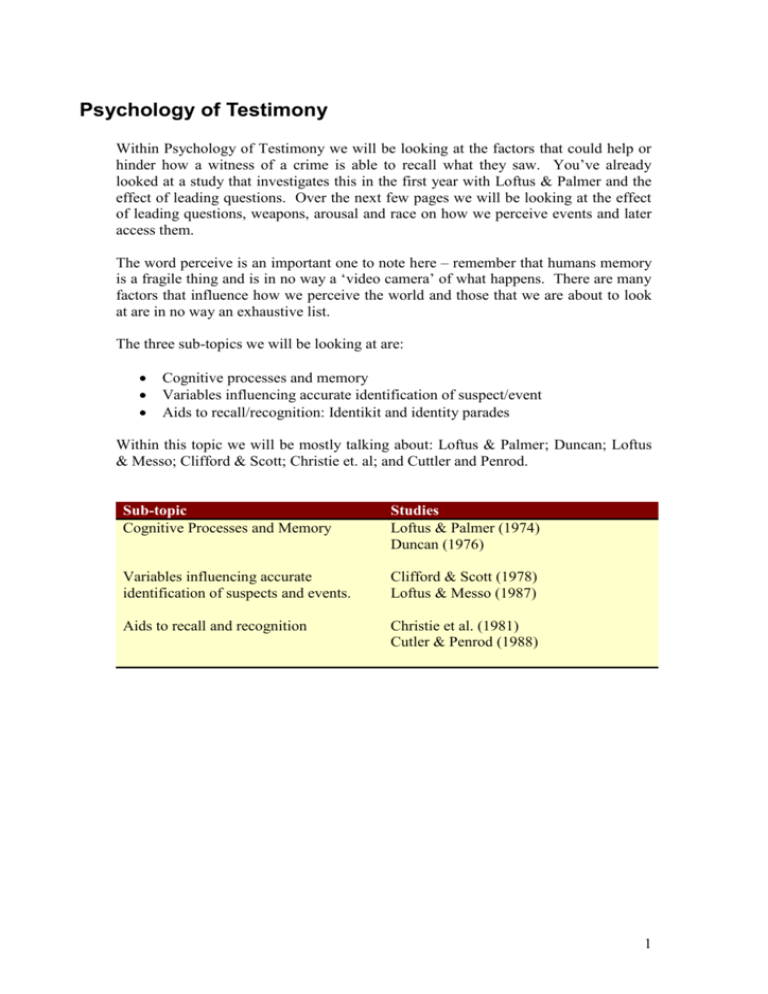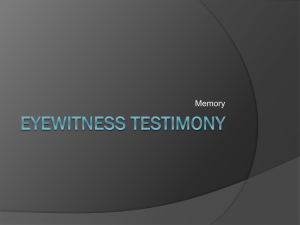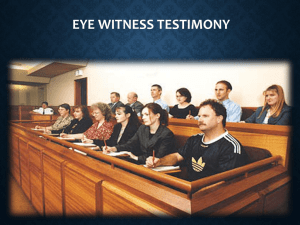Psychology of Testimony
advertisement

Psychology of Testimony Within Psychology of Testimony we will be looking at the factors that could help or hinder how a witness of a crime is able to recall what they saw. You’ve already looked at a study that investigates this in the first year with Loftus & Palmer and the effect of leading questions. Over the next few pages we will be looking at the effect of leading questions, weapons, arousal and race on how we perceive events and later access them. The word perceive is an important one to note here – remember that humans memory is a fragile thing and is in no way a ‘video camera’ of what happens. There are many factors that influence how we perceive the world and those that we are about to look at are in no way an exhaustive list. The three sub-topics we will be looking at are: Cognitive processes and memory Variables influencing accurate identification of suspect/event Aids to recall/recognition: Identikit and identity parades Within this topic we will be mostly talking about: Loftus & Palmer; Duncan; Loftus & Messo; Clifford & Scott; Christie et. al; and Cuttler and Penrod. Sub-topic Cognitive Processes and Memory Studies Loftus & Palmer (1974) Duncan (1976) Variables influencing accurate identification of suspects and events. Clifford & Scott (1978) Loftus & Messo (1987) Aids to recall and recognition Christie et al. (1981) Cutler & Penrod (1988) 1 Cognitive processes and memory As you should remember from the core studies in the first year, we studied eyewitness testimony and how Loftus and Palmer found that they could distort a participants’ memory of an event through the use of a leading question. Eye Witness Testimony has a very important role to play in jury decisions. It would appear that the report of a confident witness often serves to convince the jury of the guilt of the suspect. The reliability of such reports must therefore be scrutinised as the repercussions of being able to distort memory through leading questions are massive. Loftus and Palmer 1974 – Leading questions and memory They showed participants a film of a car crash and asked them to assess the vehicles’ speed at the time of impact. The critical question was: ‘How fast were the cars going when they hit?’ For other groups, ‘hit’ was replaced with ‘smashed’ or ‘bumped’. Results showed that the ‘smashed’ group estimated an average speed of 40mph, the ‘bumped’ 38mph and the ‘hit’ 34mph. These results can be explained in two ways. One is that participants were responding to demand characteristics, in other words, behaving in the way they thought the experimenters expected. Alternatively their memory could have been undergoing a change; a reconstruction. Loftus and Palmer carried out a second experiment in order to ascertain which argument was correct. They did this by leaving a week gap between the viewing of the film and the questioning. They came to the conclusion that misleading questions cause a reconstruction of events so original material is lost from memory. Evaluation Strengths Reliability: the study is easy to replicate therefore we can check its reliability. Control: You can determine cause and effect as you can control confounding variables (e.g. all watched same video clips). Useful applications: suggests leading questions should not be used in a courtroom as it could lead to distortion of memories. 2 Weaknesses Generalisations: Sample is unrepresentative as all white US students - leading questions might only affect the eye-witness testimony of this group. Individual Differences: Individual differences not accounted for through experimental design. Weakness as some might have better memories in certain groups. Ecological Validity: not real situation – all the participants watched a video of a crash not the real event. Duncan 1976 – The effect of race on perception Could the race of people involved in a crime really effect how we perceive an event? Psychologists have attempted to see if the race of a person involved in a crime; or more importantly the race of a witness in relation to those involved in the crime could have an effect on the perception of the event. The study which we are going to look at now is Duncan (1976) who set out to establish whether actions committed by a person of one race might be perceived differently from identical actions performed by a member of a different race. One thing that I think is important to keep at the front of your mind when you’re reading this study is the historical relativity of the study. The study was conducted in the early seventies – maybe the overall perception of people from other races was different then? Would we get the same results if we conducted the study today? Keep asking yourself these questions as you go through the study. The participants in this study watched a videotape of an altercation (fight) between two people. An argument became gradually more heated until eventually one person pushed the other. After viewing the videotaped incident the participants were asked to describe what they had seen. All participants were white, US college students. There were two versions of the videotape: In one version the person who pushed the other was white; In one version this person was black. The videotapes were otherwise identical and all viewed by groups of white students. The participants were asked whether the behaviour the person who pushed the other could be categorised as 'playing-around' or as 'violent behaviour'. When the person who started the fight was white only 13 % of participants chose to label the actions as violent behaviour. However, when the perpetrator was black 70 % of participants labelled the behaviour as violent. This difference is highly significant considering that the students all saw the same exact actions, with only the race of perpetrator changed. The results of this study have obvious implications for eyewitness testimony. If these participants were to appear as witnesses in court, their version of what they saw (or, more correctly, perceived) would clearly be affected by whether the defendant was black or white. Now think back to the questions at the beginning of this study – would the results be the same today? 3 Evaluation Strengths Reliability: the study is easy to replicate therefore we can check its reliability as the procedure was standardised (all participants saw the same thing). Control: You can determine cause and effect as you can control confounding variables (e.g. all watched same video clips). 4 Weaknesses Generalisations: Sample is unrepresentative as all white US students. Individual Differences: Individual differences not accounted for through experimental design. Could some of the participants have been racist to start off with? Ecological Validity: not real situation – all the participants watched a video not the real event. Historical relativity: racism may have been more prominent in the ‘70’s. Variables influencing accurate identification of suspects / events When a violent event happens the police expect that witnesses will remember everything ‘just as it happened’. However, as we have seen above there are factors that can influence our memories of events. This topic is going to be looking specifically at what factors influence our ability to identify a suspect rather than just looking at how we perceive an event. There are numerous factors that can influence accurate recall of an event. Here we will look at two factors (violence distraction and weapon focus) it is important to note that there are many others. Clifford and Scott 1978 - Violence Distraction: The effect of Arousal on recall Much research has found that the level of violence witnessed can affect eyewitness memory for that event, such as research by Clifford and Scott (1978). In their lab study, participants were separated into two groups. One group witnessed a violent film and one group witnessed a non-violent film. As a control, both films involved the same people, and lasted the same amount of time. The only difference was that the violent film had images of physical assault etc. After participants had watched the films, their recall was tested (i.e. names of characters, what they looked like etc.). The results showed that recall was significantly poorer for participants who had watched the violent film. The Yerkes Dodson Law of arousal can best explain these results. It would seem common sense to assume that being a witness to a criminal event could put the witness under considerable stress, especially if the event witnessed was serious. The Yerkes Dodson law of arousal indicates that arousal levels can have an effect on performance, arguing that we perform poorly when we are at both low and high levels of arousal. We perform best at a medium level. This law can be applied to the witnessing of a crime. It may be expected that witness recall would be poor since it involves a high level of arousal. It is extremely difficult to study such topics due to ethical reasons. This shows the Yerkes Dodson Law of arousal – a person’s performance depends on amount of arousal, e.g. too much or too little, and performance will be poor. 5 Evaluation Strengths Reliability: the study is easy to replicate therefore we can check its reliability as the procedure was standardised (all participants saw the same thing). Control: You can determine cause and effect as you can control confounding variables (e.g. all watched same video clips). Weaknesses Individual Differences: Individual differences not accounted for through experimental design. Ecological Validity: not real situation – all the participants watched a video not the real event. Ethics: the participants in the violent condition could have been adversely effected (ethic – protection) Loftus and Messo 1987 – Weapon Focus Experimental studies have shown that if a witness to a crime sees the perpetrator wielding a weapon, for example a gun or a knife they will tend to remember the details of the weapon but be less accurate on the other aspects of the scene, including the perpetrator’s face, this is known as the weapon focus effect. Loftus and Messo (1987) argue that this occurs as the presence of a weapon focuses attention away from the less dramatic visual images. In their lab study, participants viewed a film of a restaurant scene with a customer holding either a gun or a chequebook. The participants in the “cheque” condition were more successful at identifying the suspect in an identity parade than were the participants in the “gun” condition. They also answered specific questions about the events more accurately. This suggests that in the violent condition, participants concentrate on the weapon, rather than the other details of the event. She found that witnesses looked longer and more often at a gun in a slide sequence than at a neutral object. Reasons for this include emotional arousal, which cause the witness to process and remember accurately central information. However this effect has been found in simulated situations in which participants looked at pictures or videotapes of a scenario in which there is little if any threat. This therefore raises questions of validity (is the experiment testing what it claims to) and ecological validity (it is not true to life as less emotions are involved). Other psychologists argue that it is not the weapon but the unusualness of the situation that produces this result. Evaluation Strengths Reliability: the study is easy to replicate therefore we can check its reliability as the procedure was standardised (all participants saw the same thing). Control: You can determine cause and effect as you can control confounding variables (e.g. all watched same video clips). 6 Weaknesses Ecological Validity: not real situation – all the participants watched a video not the real event. Validity: Critics argue it is not the weapon that affects accurate identification of offenders, but the unusualness of the situation. 7 Aids to Recall and Recognition: identikit and identity parades When considering how we can improve the reliability of identification, we need to bear in mind that when someone is a witness to a crime and is asked later to try and identify the suspect, they need to be able to recognise a strange face which they have only seen briefly in conditions that are very different from those of the crime scene. This is made more difficult if the person is disguised or presented in a ‘still’ form as they might be in an identity parade or in photographs. Christie, Donald & Ellis, Hadyn 1981 – Verbal recall Vs. Photofit Here Christie et al. aimed to compare the effectiveness of verbal recall of faces with that of ‘photo fit’ technique used by the police. They tested 36 participants recruited from their Psychology department, which included 27 women and 9 men aged between 29-63 years (see below for how participants were assigned). This was an experiment conducted in two stages: 1. Face recall by description and by photo fit construction 2. Evaluation (by ‘judges’) of their respective accuracy. The first stage of the experiment was required to produce both a verbal description and photo fit for a selection of ‘target’ faces. Participants were shown one of six photographs of a target face for 60 seconds and then, from memory, construct a photo-fit likeness and then give a verbal description of the face. Each participant only viewed one photograph. A ‘Standard Male Caucasian Photo Fit Kit was used for the construction of the photo fit. This divides the face into five features: forehead/hairstyle, eyes, nose, mouth and chin and each feature is selected from a visual index. They were then asked to describe the face and all the details were recorded. At the end of the description if the participant had not mentioned any of the five features listed above they were prompted to do so. The second stage of the experiment was designed to test the effectiveness of each of the two methods used in the first stage of the experiment. This second stage was split up into a further two stages: identification and sorting. From the first experiment there were six verbal descriptions and six photo fits for each of the 6 photographs (36 in total). In the identification task each participant was presented with the 6 original target faces mixed in with 18 other distracter faces. This ‘judge’ was then given a set of 6 cards; on these 6 cards were either 8 descriptions of 6 different faces, or photo fits of 6 different faces. The task was to match up the 6 cards with the original target face used to create them in the first stage. The second ‘evaluation task’ was the sorting task. This time two groups of ‘judges’ were recruited from students at the University. Each group was given the complete set of either the 36 descriptions or 36 photo fits created in the first stage of the study along with the 6 original target photos. This time the task was to sort the 36 cards into 6 piles of 6 – therefore showing which 6 descriptions / photo fits came from the original photographs. Results showed that analysis of both the identification and the sorting tasks suggest a marked superiority for verbal descriptions over photo fit constructions. This has obvious implications for police procedure as it suggests that recording a detailed description of the person should be given priority over the creation of a photo fit image. 9 Evaluation Strengths Useful Applications: police should get verbal descriptions rather than photo fits from witnesses. Reliability: easy to replicate this study so we can test the reliability. Weaknesses Ecological Validity: not real situation. Participants hadn’t witnessed a real crime therefore could remember less of the original photo. Validity: could be measuring demand characteristic – participants could have focused on different things knowing that they would have to describe / photo fit the photograph. Historical Context: again another study conducted in the 80’s – there have been massive jumps in technology – maybe photo fits will be better? Cutler and Penrod 1988 – One at a time? Research shows that witnesses frequently make mistakes when trying to select someone from an identity parade. Witnesses are likely to choose someone in similar clothes to those worn by the culprit than select them based on height and facial features. As criminals often change their appearance before an identity parade this may also hamper the identification process. Another problem with identity parades is that people assume that the suspect is present and will therefore identify someone who closely resembles the person that they saw. This may cause problems if all the people in the line up resemble the culprit. Cutler and Penrod (1988) used a different type of identity parade called a sequential line up. The individuals in the line up are seen one at a time and the witness has to say yes or no according to whether or not they recognise them. This makes it less likely that they will choose the one who most resembles the culprit. Cutler and Penrod conducted experiments in which undergraduate participants watched a videotaped re enactment of an armed robbery and later attempted to identify the robber from an identity parade. They found that participants were significantly more accurate in their identification on the sequential line up than on the traditional one and were less likely to make a false identification. 10 Exam Questions Section A a. Describe evidence that suggests cognitive processes affect testimony. [6] b. Evaluate research that has investigated how cognitive processes affect [10] testimony. Section B a. Describe what psychologists have found out about witness testimony. [10] b. Evaluate what psychologists have found out about witness testimony. [16] c. Suggest ways that the police can increase the accuracy of witness [8] testimony. Give reasons for your answer. 11




